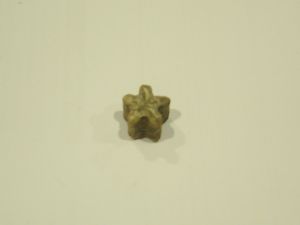|

Crinoids are commonly preserved in
limestones. Their disc-shaped columnals which make
up their segmented stems are often found in
abundance, and it is around these that folklore has
developed.
The folklore name of St. Cuthbert's Beads originated
from a belief that the monk St. Cuthbert (634-687
AD), who became Bishop of Lindisfarne, carved the
disc-shaped beads on a stormy night so they could be
found on the beach the next morning. This legend is
depicted in Sir Walter Scott's Marmion (1808):
"But fain Saint Hilda's nuns would learn
If, on a rock by Lindisfarne,
Saint Cuthbert sits, and toils to frame
The sea-born beads that bear his name:
Such tales had Whitby's fishers told
And said they might his shape behold,
And here his anvil sound:
A deadened clang - a huge dim form
Seen but and heart when gathering storm
And night were closing round.
But this, a tale of idle fame,
The nuns of Lindisfarne disclaim"
Crinoids have also been known as Star Stones, so
called because of their pentagonal shaped columnals.
Star Stones were thought to have come to earth from
the heavens. It was believed the star shaped
columnals were generated in the clouds and sent to
earth in times of thunder and violent showers.
|








